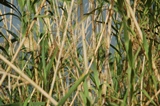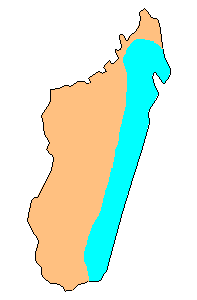Weaver species
Choose different species from drop-down list and press 'Go' button. See Full species list.Nelicourvi Weaver Ploceus nelicourvi
IUCN: Least concern Discovery: 013Categories: long tube, island, blue eggs,
News items about species
Discovery
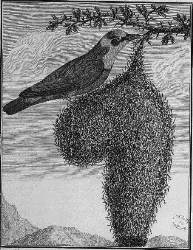
figure from Sonnerat 1782 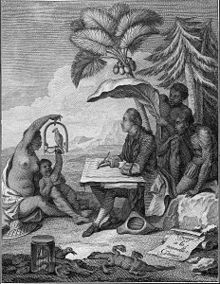
of the Nelicourvi Weaver, figure from wikipedia 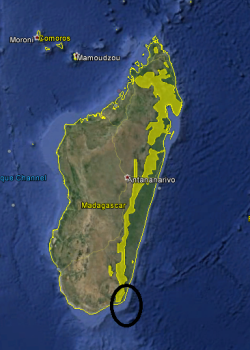
type locality circled IntroductionThe Nelicourvi Weaver was formally named by Giovanni Antonio Scopoli, a Tyrolean naturalist, in 1786. Scopoli gave a scientific name and description of the Nelicourvi Weaver in Latin, based on the publication of Pierre Sonnerat.Sonnerat made several voyages to southeast Asia, visiting the eastern coast of Madagascar in 1770 (Sonnerat, French text). He visited Fort Dauphin near the south, but probably also visited other ports along the coast. He also observed the nests of the Nelicourvi Weaver, noting the long entrance tube and that several could be found in 1 site. Sonnerat published his travel diary in 1776. Sonnerat provided a French name (Le Nelicourvi de Madagascar, the finch of Madagascar) while Scopoli, who had been corresponding with Carl Linnaeus, provided a binomial name and thus is credited as author of the Nelicourvi Weaver. Scientific citationParvus nelicourvi Scopoli 1786 Del. Flor. Faun. Insurb., fasc. 2, p.96 Madagascar, ex Sonnerat, pl. 112.Meaning of namesparvus (Latin) = small, little.nelicourvi = doubtless from the Tamil (Sri Lanka) name nellukuruvi for a finch or waxbill, the Madagascan Nelicourvi Weaver thought to have come from Indomalaya. First English namePensile Grosbeak (Latham 1783).Alternate namesNone.CollectorPierre Sonnerat.Date collected1770, when Sonnerat visited Madagascar.Locality collectedEast coast of Madagascar, possibly Fort Dauphin.Type specimensNo type specimens known to survive, but the painting of Sonnerat serves as a type. |
The above is based on Weaver Wednesday 2, a weekly series about the discovery of each weaver species.
This species text first appeared as
Weaver Wednesday [130] - Discovery [13]: Nelicourvi Weaver on 2014-12-10
1. Basic biology


Identification. The male Nelicourvi Weaver Ploceus nelicourvi has a black helmet, surrounded by a yellow band and grey underparts; the undertail-coverts are a conspicous rufous-chestnut (photo far left, from phown 179). The female resembles the male, but the black head is replaced with yellow, but with grey lores, and olive crown patch (photo right, from phown 920). The name is thought to be a Sri Lankan word (nellukurvi) for finch. Distribution. The Nelicourvi Weaver is endemic to forests of eastern Madagascar (see light blue on map below), based on Handbook of the Birds of the World, Vol. 15). There are no subspecies. Habitat. The Nelicourvi Weaver occurs in rainforest and secondary forest from sea level up to 1950 m, also at forest edges, in secondary habitats and village gardens near forest. Food. The Nelicourvi Weaver feeds on insects, like beetles, bugs (Hemiptera) and grasshoppers; also spiders and possibly fruits. They regularly join mixed-species flocks of insectivorous birds. Breeding.
This species is monogamous, and probably has a long-term pair-bond. They are solitary breeders, with one nest, or sometimes two nests at a site but only one occupied. The nest (right, from phown 1028) has an entrance tunnel which varies in length, up to 20 cm long. The male suspends the nest above the ground, over a path or clearing, or suspended over a stream. The extent to which the sexes share incubation and feeding of the young is unknown.
|
The above is based on Weaver Wednesday, a weekly series about weaver species.
This species text first appeared as
Weaver Wednesday [21]: Nelicourvi Weaver on 2012-11-07
2. Breeding facts
| Pair bond Monogamous, probably with long-term pair-bond Breeding season Sept-Dec Nest site 2-7 m above ground, often suspended over stream, or over path or clearing Nest building woven by male, female may contribute lining material Colony size Solitary, with nests widely separated; sometimes two nests at a site, only one occupied, perhaps built by same individual Clutch size 2-4 eggs, most often 3 Egg colour pale greenish-blue Egg size average size 21 x 15.5 mm Incubation female seen while incubating, but roles of sexes in incubation undescribed Chicks and nestling period fledglings fed by both parents |
Breeding information based on Handbook of the Birds of the World, Vol. 15.
3. Photos of Weaver Nests
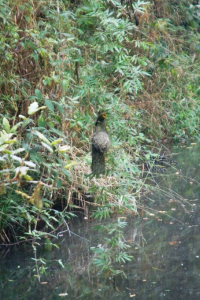 Vm 15244 | 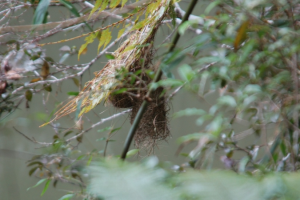 Vm 15243 |  Vm 15242 |  Vm 15241 | 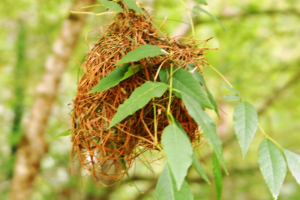 Vm 15240 |  Vm 11893 |
Thumb-nails of most recent PHOWN records - click on one to see its full record
See all PHOWN records for this species here.
PHOWN (Photos of Weaver Nests) provides valuable info on breeding distribution and colony sizes of weavers.
You can contribute by registering and submitting photos at Virtual Museum webpage.
4. Breeding distribution
Google map showing distribution (For species with small ranges you need to zoom in at the correct area to see the range):
yellow blob - range of weaver species; read more about this here.
![]() - PHOWN records with photos
- PHOWN records with photos
![]() - PHOWN records with no photos (Nest Record Cards, other records)
- PHOWN records with no photos (Nest Record Cards, other records)
![]() - Birdpix records
- Birdpix records
![]() - comments on out of range records, or interesting records
- comments on out of range records, or interesting records
![]() - type locality
- type locality
CLICK on the marker on the map to see individual record details.
5. Range changes
Not South African speciesThe above is based on Weaver Wednesday 3, a weekly series about range changes in South African weaver species.
This species text first appeared as
n/a








